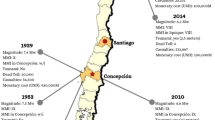Abstract
This paper studies responses to the 1999 Marmara Earthquake (Turkey) in which 18,000 people died, 50,000 people were injured, there were 5,000 building collapses and 340,000 damaged buildings, 14,513 businesses closed, 150,000 people became unemployed, and 129,338 were forced to live in prefabricated houses. This research is based on a survey comprising 500 interviews carried out a year after the earthquake. Responsible behavior as the dependent variable is statistically tested with several socio-demographic and attitude variables. The findings indicate social solidarity, knowledge, basic needs, desire for change and psychological status of the disaster survivors were all adversely affected. It was observed that education, employment, social security, knowledge and fatalism have varying impacts on responsible behavior related to preparedness for future earthquakes.
Similar content being viewed by others
REFERENCES
Ak?it, B. & Karanc?, A.N. (1999a). Social and Psychological Lessons Learned from Dinar Earthquake and Mitigation Activities in Bursa. In E. M. Komut (Ed.), Urban Settlement and Natural Disasters, Proceedings of UIA Region II Workprogramme Workshop, Proceedings of UIA Region II Workshop Chamber of Architects of Turkey, Ankara, 37–50.
Ak?it, B. & Karanc?, A.N. (1999b). Strengthening Community Participation in Disaster Management and Non-Governmental Organizations Networks: A Case Study from Dinar and Bursa (Turkey). The Australian Journal of Emergency Management 13 (4), 35–39.
Alexander, D.E. (2000). Confronting Catastrophe: New Perspectives on Natural Disasters. New York: Terra.
Anderson, W.A. (1969). Disaster Warning and Communication Processes in Two Communities. Journal of Communication 19 (2), 92–104.
Barton, A. (1969). Communities in Disaster: A Sociological Analysis of Collective Stress Situations. New York: Doubleday.
Bates, F. L. & Peacock, W. (1987). Disasters and Social Change. In R. Dynes, B. De Marchi & C. Pelanda, W. (Eds.), Sociology of Disasters. Milan: Franco Angeli.
Bolin, R.C. (1994). Post Disaster Sheltering and Housing: Social Processes in Response and Recovery. In R.R. Dynes & K.J. Tierney (Eds.), Disasters, Collective Behavior and Social Organisation. Newark: University of Delaware.
Davis, I. (1981). Disasters and the Small Dwelling. Oxford: Pergamon.
Dynes, R.R. (1970). Organised Behavior in Disaster. Massachusetts: Lexington.
Erikson, K. (1976). Everything in its Path. New York: Simon and Schuster.
Fisbein, M. & Ajzen, I. (1975). Belief, Attitude, Intention and Behavior: An Introduction to Theory and Research. New York: Addison-Wesley.
Gerrity, E.T. & Steinglass, P. (1994). Relocation Stress Following Natural Disasters. In R. J. Ursano, B. G. McCaughey & C. S. Fullerton (Eds.), Individual and Community Responses to Trauma and Disaster. Cambridge: University Press.
Hines, J.M., Hungerford, H.R. & Tomera, A.N. (1986/7). Analysis and Synthesis of Research on Responsible Environmental Behavior: A Meta Analysis. Journal of Environmental Education 18 (2), 1–8.
Karanc?, A. N. & Ak?it, B. (1999) Strengthening Community Participation in Disaster Management by Strengthening Governmental and Non-governmental Organisations and Networks: A Case Study from Dinar and Bursa (Turkey). The Australian Journal of Emergency Management 13 (4), 35–39.
Karanc?, A.N., Alkan, N., Ak?it, B. & Balta, F. (1999). Gender Differences in Psychological Distress, Coping, Social Support and Related Variables Following the Dinar (Turkey) Earthquake. North American Journal of Psychology 1 (2), 189–204.
Kasapo?lu, M.A. & Ecevit, M.C. (2002). Attitudes and Behavior Towards the Environment: A Case of Lake Burdur in Turkey. Environment and Behavior, 34 (3), 363–377.
Menard, Scott (1995). Applied Logistic Regression Analysis. Thousand Oaks, CA: Sage Publications Series: Quantitative Applications in the Social Sciences, No. 106.
Oliver, P. (1971). Shelter in Africa. New York: Praeger Publishers.
Oliver-Smith, A. (1986). The Martyred City. Albuquerque: University of New Mexico Press.
Quarantelli, E.L. (1998). What is a Disaster? Perspectives on the Question. London: Routledge.
Wallace, A. F. C. (1956). Tornado in Worcester. National Research Council Disaster Study No 3, Washington D.C.: National Academy of Sciences.
Author information
Authors and Affiliations
Corresponding author
Rights and permissions
About this article
Cite this article
Kasapoğlu, A., Ecevit, M. Impact of the 1999 East Marmara Earthquake in Turkey. Population and Environment 24, 339–358 (2003). https://doi.org/10.1023/A:1022453722574
Issue Date:
DOI: https://doi.org/10.1023/A:1022453722574




